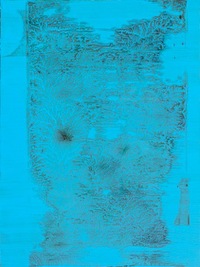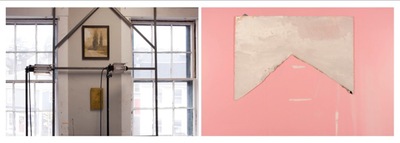Bernd Haussmann
By Craig Stockwell
Bernd has a studio in Marblehead, MA, located on the third floor of an aged building in the scenic old town with a view through to the harbor. I had met Bernd in Provincetown and was interested in his painting and have enjoyed his enigmatic Facebook postings entitled, “Now.”
Bernd is an accomplished painter raised and trained in Germany and his commitment to the rigors of private studio practice were immediately apparent as was his general disapproval of the slightness of much of contemporary art. What’s interesting is that he is in the midst of a changing practice wherein he is moving on to new projects that reflect on the nature of painting, and the idea of what an artist, is in a way that is opening possibilities fundamentally different from those of where he’s begun.

Darwin’s Coral
Haussmann has been involved in a variety of current painting projects. His painting is based in finding a process that motivates the making of a painting and then widely exploring that process to contact a wide range of manifestations. In best painterly form he determinedly makes an effort to steer against the obvious and the likely. Haussmann works hard to approach each painting as an opportunity to undo all that seems to be working smoothly and the risk and effort he undertakes makes for committed and exciting painting. For example, in his current series entitled Darwin’s Coral, the paintings are constructed using some sort of adhering and peeling technique wherein the paint forms into coral-like structures as something is adhered to the painting and then peeled away. This is a process involving both crafted precision and acceptance of chance.
While perusing Bernd’s website I came across the following:
Conceptual art has more and more become an academic art, for people who don’t know how to make even academic art, and race, gender, and AIDS continue to elicit their quota of high-minded, self-righteous work. What light-years it seems from the huge ambitions– spiritual, formal, or rawly ego-driven –of a Malevich, a Mondrian, a Pollock, a Serra, even a Julian Schnabel.
I am quoting Anthony Haden-Guest, True Colors, who wrote this about 10 years ago.
So where are we now? What has happened since? If, as so many believe, art is moving in cycles (just like the fashion world) then aren’t we overdue for a turn towards emotional and gestural art again?
This statement got my attention. I recoiled at Haden-Guests’ narrow and reactionary take on conceptual art, and further recoiled at Haussmann’s apparent call for a return to neo-expressionism, and (as always) also felt a tinge of a pull towards these sentiments as well.
For myself, I find two voices in my head when presented with looking at new efforts of artists. One voice disapproves; the other voice stands in curious amazement. I think that each voice has its uses and one of the battles of a (somewhat) aging artist needs to struggle with is the cranky/grouchy voice.
Our insights and experience are hard won and it is annoying as Hell that the ground under us refuses to settle into firm foundations. And there are a lot of things tried and presented that are no good. And yet, art is a response to context. Context is continually in flux. I don’t think that there is much credibility remaining for arguments for universal truths and truly “authentic” art. Authentic art happens in the chaotic flush of daily interaction, not in the hallowed calm of a distant studio. It just doesn’t seem to work that way anymore. And I feel thankful for having been pulled out into the world.
Haussmann is being pulled out into the world. It began in New York where he was successfully showing at a Chelsea gallery but that soured as the gallery began to insist on a consistent size, palette and format for the paintings. Haussmann also began to realize that he was becoming an “arrogant, stressed, asshole.” His painting continues as committed as ever and a wide range of exhibitions and galleries remain on his list. But now the other elements occurring in his work offer fresh possibilities. The studio artist can continue on now, challenged and expanded by other possibilities.
Broad Institute: Artist in Residence
One project that Haussmann has begun is working with the Broad Institute in Cambridge. Haussmann is working on a project of collaboration and interaction it is formative at this point but so far consists of the following elements: Acrylic panels installed in the labs with permanent paint markers distributed to the researchers and the invitation to “make notations,” much as they are constantly doing on their ubiquitous laboratory whiteboards. Haussmann will then take the panels back to his studio and paint in a way that interacts with the notations. This process will repeat a few times until the panels are “finished.”
Haussmann says, “I think it’s crucial that the dialogue is made clear between the two disciplines of art & science. They talk in their ‘language.’ I talk in mine. But we create something together. When the ‘conversation’ is finished, the paintings will be taken out of the environment(s) of their creation & installed in a museum setting. In order to hopefully stimulate a new ‘dialogue’.” In addition, Haussmann is considering the specialized spoken language of researchers and artists. He is recording both the Institute’s research meetings and artists’ panels and using those recordings as a basis for a sound installation entitled Babylon.
Another, equally important project at the Broad is collecting “scribbles” from different scientific groups and overlaying them, one layer over the other, until their “concrete” language becomes an abstract work of art. The result will also be printed on large acrylic sheets, like a “dialogue.” This entire Broad Institute project represents both an expansion of the possibilities of a painting process and a move into a complex consideration of language. These projects will be recorded and documented in a book format, including visual records of all steps of the progress of the acrylic panel works.

Bernd Haussmann with Lost Paintings
Lost Paintings
Another project consists of working with panels that are used as tabletops during the regular process of developing ongoing paintings. These tabletops are placed where all the paint is mixed and much is spilled and dripped in the process. They are allowed simply to develop over time and are eventually replaced with a fresh board.
This simple conceptual process raises interesting questions immediately about the possibilities of truly unconscious work: at what point does one begin, consciously, to consider the unconscious dripping or the colors being accumulated? The process has resulted in some surprisingly satisfying painting:

Tabletop Lost Painting
The Idea of Photography
Haussmann’s first worked as a photographer and he still maintains that he works from a “photographic eye.” This affects his painting and various projects as well. He has worked with a photographer, Rick Ashley, to document his studio in an interesting fashion. First, Ashley spent a week photographing in the studio, anything that caught his eye. Then, Haussmann spent a week taking photographs wherein he intervened, arranged and composed (Ashley had not touched a thing). Paired images were the result.
Yes, there is a place in this array of projects for gestural and emotional painting. But it’s important to note that Haussmann has created a place for that language amongst the babble of other art languages that he, himself, is considering and speaking.
Craig Stockwell is an artist, writer, and contributor to Art New England. His Studio Visit column appears periodically in the magazine and online, as here.

